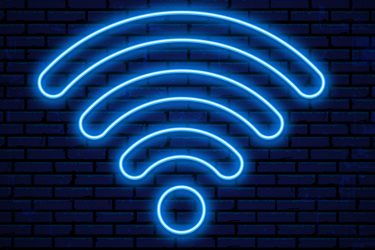6E, Or Not 6E, That Is The Question

By John Oncea, Editor

5G is here, and 6G is on the way, now that the FCC has announced conditional approval in the 6 GHz band for Automated Frequency Coordination.
Tiago Rodrigues, CEO of the Wireless Broadband Alliance, said of the ruling, “The WBA are honored by the FCC’s conditional approval to finalize development for operating as one of 13 possible automated frequency coordination (AFC) system operators in the 6 GHz band and prepare for testing. This is the latest milestone in enabling U.S. consumers and businesses to take full advantage of the 6 GHz band.”
This conditional approval is paramount in paving the way for faster Wi-Fi – including 6G – but why stop there? The myriad of options 6 GHz presents includes 6E which will theoretically bring with it a 30% increase in speed and fewer glitches when there are too many devices in use nearby, as reported by EuroWeekly.
But is 6E (the “E” stands for extended) an upgrade you need to seriously consider? After all, as HighSpeentInternet.com points out, “Technically, 6G doesn’t exist yet. But theoretically speaking, it could end up being a lot of things, building on current network and technology trends to help make a completely new type of internet.” 6G isn’t only going to support mobile phones, it “could also be used for technology like automated cars and smart-home networks, helping create a seamless connectivity between the internet and everyday life.”
Expected to be up and running by 2030, it’s important to remember that 6G is still “just a bunch of ideas at the point.” But it’s coming and is bringing along with it 6E.
What 6E Brings To The Table
So, what’s this 6E you speak of? In January 2020, Wi-Fi Alliance announced it was “introducing new terminology to distinguish forthcoming Wi-Fi 6 devices capable of 6 GHz operation, an important portion of unlicensed spectrum that may soon be made available by regulators worldwide.
“Wi-Fi 6E brings a common industry name for Wi-Fi users to identify devices that will offer the features and capabilities of Wi-Fi 6 – including higher performance, lower latency, and faster data rates – extended into the 6 GHz band. Wi-Fi 6E devices are expected to become available quickly following 6 GHz regulatory approvals, utilizing this additional spectrum capacity to deliver continuous Wi-Fi innovation and valuable contributions to consumers, businesses, and economies.”
6E will bring a stronger connection and allow for proper analytics to keep track of connectivity issues, two things every market will benefit from. Consider, for instance, healthcare, where hospitals rely on medical devices to ensure patients are constantly monitored. A reliable Wi-Fi system is necessary to accommodate the high capacity of patients to ensure they’re safe and taken care of.
Additionally, Wi-Fi in healthcare facilities is connected to beds and thermostats, and obtaining analytics helps provide insight to determine what Wi-Fi automation would be a solution. To help determine what is needed to meet the technology goals, it’s pertinent for IT teams to evaluate the Wi-Fi 6E advantages, including lower latency (think instantaneous responses to keyboard commands, mouse clicks, or voices), faster data rates that will enable Wi-Fi networks to send and receive information faster, and higher capacity (each Wi-Fi 6E AP can cover around 1,500-2,000 square feet).
Technically Speaking …
Dong Ngo, writing for Dong Knows Tech, goes into great detail about many of 6E’s technical aspects. Check out his article for the nitty gritty, but here’s an abridged look at what Ngo has to say: “When it comes to Wi-Fi, it’s always getting connected at the time of need and not having the latest and greatest that matters. And the new 6GHz band doesn’t mean the good old 2.4GHz and 5GHz bands are on the way out. It’s an additional band that’s not meant to replace anything.”
While Ngo’s review doesn’t discredit 6E it does leave one asking if the technology is truly needed. That’s the very question Wired answers here.
In a nutshell, “If you’re shopping for a new router or looking at mesh systems, you will certainly want to look for Wi-Fi 6 support. There are many other ways to make your Wi-Fi faster, but buying a Wi-Fi 6 router is an important one.”
But what about bumping up to 6E? Wired writes this is a trickier question to answer, starting with the fact that it requires new hardware. “Only routers and devices with Wi-Fi 6E support can operate on this newly opened 6-GHz band,” notes Wired. “Existing Wi-Fi 6 routers and any older devices cannot and will never be able to.”
Telecoms.com weighs in as well, noting that 6E “extends the same Wi-Fi 6 capabilities into it, enabling far greater efficiency, increased throughput, and tighter security. The extension into this band essentially doubles the amount of frequency that is available to devices and users. While not the only solution – the rollout of 5G is a noteworthy answer to connectivity issues – Wi-Fi 6E gives an organization far greater control over how their data is treated, and it is also cheaper to boot.”
So, is 6E a technology you need? Telecoms.com offers up the following answer which seems to be fairly representative of the current thinking: “Organizations have already witnessed the compelling results of all this connectivity, such as greater efficiencies and a more refined implementation of data. Looking ahead, Wi-Fi 6E offers even more opportunities for them to transform their businesses and deliver compelling end user experiences. The choice is obvious.”
